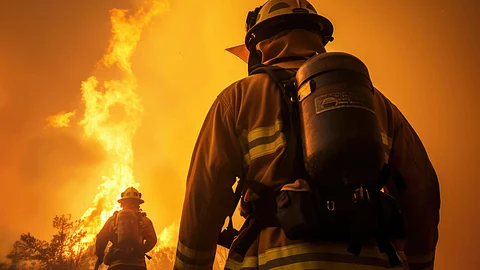
- Home
- NG Hindi
- India
- World
- Politics
- Sex & Relationships
- Entertainment
- Culture
- Lifestyle
- Economy
- Sports
- Sp. Coverage
- Misc.
- NewsGram Exclusive
- Jobs / Internships

By Abe Streep
The top Democrat on a House committee is demanding that Agriculture Secretary Brooke Rollins account for discrepancies between her public statements about wildland firefighter staffing and a ProPublica report showing there were thousands of vacancies in the Forest Service’s firefighting workforce as peak wildfire season approached.
In June, the Forest Service claimed it had reached 99% of its hiring goal for its wildland firefighting workforce. But ProPublica’s reporting indicated that the agency was selectively counting firefighters, presenting an optimistic assessment to the public. As many as 27% of jobs were vacant as of July 17, according to data obtained by ProPublica.
Rep. Robert Garcia, a Democrat from California and the ranking member of the Committee on Oversight and Government Reform, made the request to Rollins in a letter sent Thursday morning. “The Trump Administration’s staffing decisions are exacerbating an already dire situation: The Forest Service’s firefighting capacity has been dangerously hampered by Department of Government Efficiency and Trump Administration layoffs, deferred resignations, and other early retirements and resignations just as climate change is extending the fire season,” he wrote.
The Forest Service’s assertions about its readiness are contradicted not only by its own staff — a wildland firefighter in California quoted in the ProPublica report called the 99% figure “grossly inaccurate” — but by its own statistics. In July, ProPublica reported that, according to agency data, its fire and aviation management program contained more than 4,500 active vacancies, including for such crucial primary firefighting positions as hotshots, dispatchers and engine captains. At the time, a spokesperson for the Agriculture Department disputed that the Forest Service had that many vacancies within its fire and aviation management program but did not provide data showing otherwise. A spokesperson for the Forest Service later claimed that ProPublica’s figures were inaccurate, telling the High Country News, “Their numbers likely come from outdated org charts and unfunded positions.” However, ProPublica excluded all unfunded positions from its analysis, and its data came from active agency organizational charts. When asked to support its claims that the agency’s fire service is fully staffed, a spokesperson wrote: “The Forest Service is fully prepared and operational to protect individuals and communities from wildfires. The Forest Service has over 19,000 workers, both in and out of the Fire and Aviation Management group, who hold incident response qualifications.”
According to experts, the agency has long resisted providing a comprehensive and transparent breakdown of its wildland firefighting force. “Unless Congress tells them to, they’re not going to do a report of that magnitude,” said Robert Kuhn, a former Forest Service official who between 2009 and 2011 co-authored such an assessment. Kuhn cited the cost and effort involved in analyzing a sprawling and complex agency. Earlier this year, Grassroots Wildland Firefighting, a labor advocacy organization, wrote, “None of the federal agencies have developed a modern formula for determining how many wildland firefighters and support personnel are truly needed to address 21st century issues.” Most federal wildland firefighters work for the Forest Service, within the Department of Agriculture. In addition, the federal government employs thousands of wildland firefighters at four agencies in the Department of the Interior. President Donald Trump has ordered all of them to consolidate their wildland fire programs. Details about that unification have not been released.
Every year, the Forest Service reports that it has filled its ranks with what are known as primary firefighters. But according to current and former Forest Service employees, that assessment — the basis of the claim that the agency reached 99% of its hiring goal — is misleading on a number of levels. The Forest Service simply counts “operational firefighters” working within a specified pay range. That figure includes both temporary seasonal firefighters who have just joined the agency and experienced year-round veterans — but it does not distinguish between the two and therefore elides a great loss of institutional knowledge. In recent years, the agency has suffered an exodus of experienced firefighters.
The agency’s assessment also excludes both senior-level fire managers and crucial support staff. The public associates wildland firefighting with its most iconic figures: smokejumpers, hotshots and members of engine crews, who often are supported by aircraft dropping retardant. But the nation’s wildland fire apparatus also includes, for example, human-resource specialists, ecologists, wilderness rangers, meteorologists, trails workers and other employees who possess qualifications allowing them to work on a fire line. Those qualifications are listed in what’s known as a “red card.” An archaeologist could have a red card allowing them to, say, oversee the distribution of food at a fire camp.
[Pro Publica/NS]
